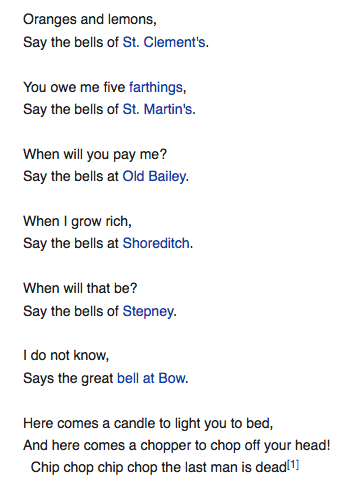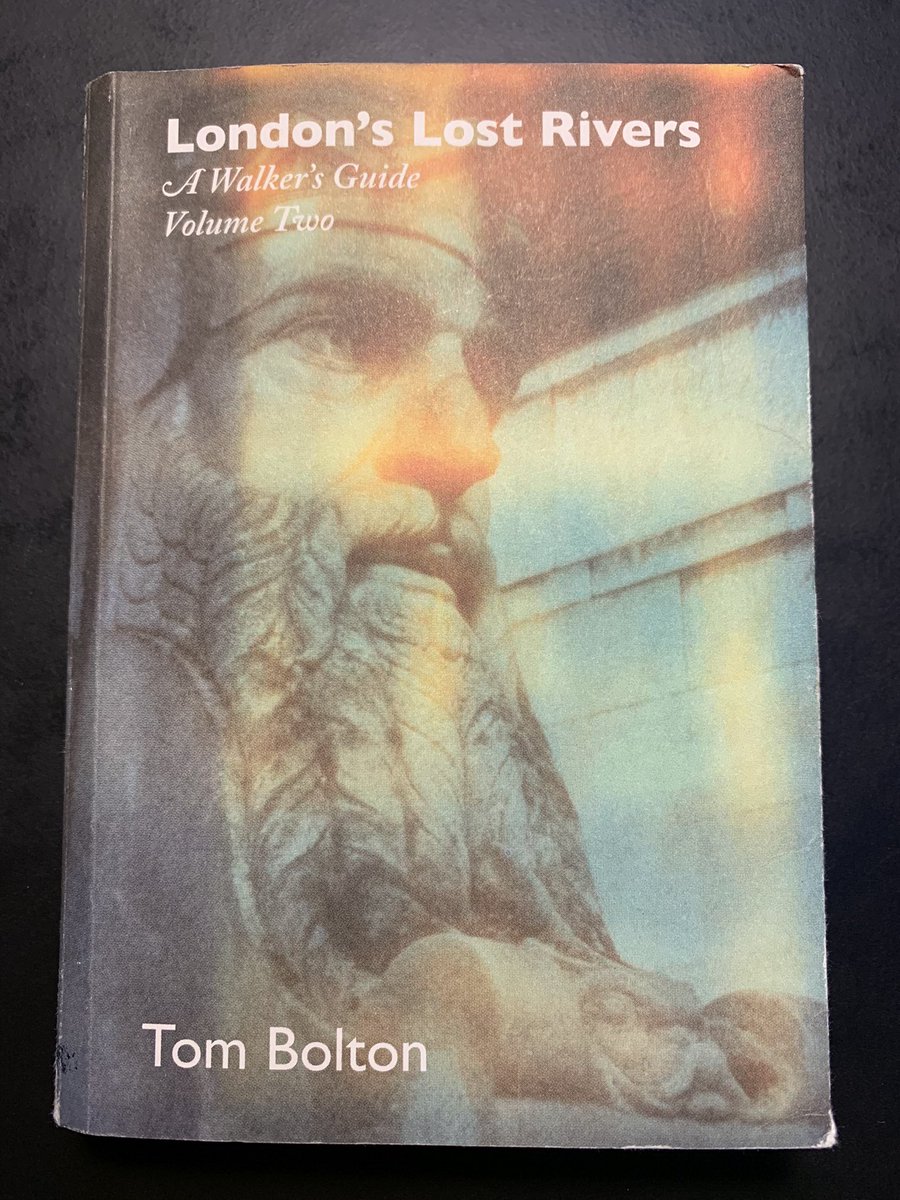
For this week's bout of Government-mandated exercise, @sadieholland67 & I are going to visit all the churches mentioned in the nursery rhyme #OrangesAndLemons*
* The idea for this came from someone who messaged me about doing the same here on Twitter. Whoever you were, thank u!
* The idea for this came from someone who messaged me about doing the same here on Twitter. Whoever you were, thank u!
#OrangesAndLemons is an ancient tune: people were dancing to it in the 1660s, & so its lyrics may bear the stamp of that fateful decade. But probably not - the earliest version yet found in print dates to 1744 (Tom Thumb's Pretty Song Book).
There are many versions of the lyrics. The earliest begins:
'2 sticks & an apple, Ring ye bells at Whitechapel,
Old father bald pate, Ring ye bells Aldgate,
Maids in white aprons, Ring ye bells at St Catherines,
Oranges & lemons, Ring ye bells at St Clements.'
'2 sticks & an apple, Ring ye bells at Whitechapel,
Old father bald pate, Ring ye bells Aldgate,
Maids in white aprons, Ring ye bells at St Catherines,
Oranges & lemons, Ring ye bells at St Clements.'
We are going to follow the standard version of the nursery rhyme - principally because it only mentions six churches, and even then it will still be quite a lengthy walk. 

What is #OrangesAndLemons about? There are various theories: it's about a condemned man going to the gallows. Or the wives of Henry VIII. Or a couple on their wedding night. None is particularly convincing. "The most likely explanation is simply the need to make things rhyme."
"Here comes a candle to light you to bed
Here comes a chopper to chop off your head."
Since these lines did not feature in any of the 4 known texts of the 18th century, "stories about the ancient significance of the game have a counterfeit look to them" - Iona & Peter Opie
Here comes a chopper to chop off your head."
Since these lines did not feature in any of the 4 known texts of the 18th century, "stories about the ancient significance of the game have a counterfeit look to them" - Iona & Peter Opie
“You owe me five farthings,
Say the bells of St. Martin's.”
But which St Martin’s? There are two candidates, & this is the first: @smitf_london.
Say the bells of St. Martin's.”
But which St Martin’s? There are two candidates, & this is the first: @smitf_london.

The Martin is Martin of Tours, the most potent saint in late antique Gaul. The discovery of a grave here dating from the early 5th C may suggests it may conceivably have been a place of Christian worship even in Roman times. In medieval times it was literally ‘in the fields’.
The current church was built between 1722-26 to a design by James Gibbs: one that has been hugely influential on the look of churches in the anglophone world beyond Britain. It is the Royal Family’s parish church.
As for the bells, the current set of 12 were cast in 1988.
As for the bells, the current set of 12 were cast in 1988.
“Oranges and lemons,
Say the bells of St. Clement's.”
St Clement Danes, one of 2 churches in the middle of the Strand, prompts a couple of obvious questions: i. Why ‘Danes’? ii. Is this the St Clements mentioned in the nursery rhyme?
Say the bells of St. Clement's.”
St Clement Danes, one of 2 churches in the middle of the Strand, prompts a couple of obvious questions: i. Why ‘Danes’? ii. Is this the St Clements mentioned in the nursery rhyme?

Why ‘Danes’? There are various theories: Harold Harefoot was buried there, after his corpse had been dumped in the Thames by his brother, Harthacanute. Or a party of Danes were killed there on the St Brice’s Day Massacre. Or Alfred let some Danes settle there. Or something.
Is it the St Clements mentioned in the nursery rhyme? It has certainly claimed to be since the 1920s. The church installed a carillon to play the tune every day, & it has an annual ‘oranges & lemons’ service.
But, even so, there’s a likelier candidate…
But, even so, there’s a likelier candidate…
The present day St Clement Danes was designed by Wren, & its steeple by Gibbs. William Webb Ellis, the inventor of rugby, was a rector here. Gutted by German bombs in 1941, it was rebuilt & reconsecrated as the Central Church of the RAF. 



Outside St Clement Danes stand statues of Air Chief Marshal Dowding, who won the Battle of Britain, & - controversially - Sir Arthur ‘Bomber’ Harris, who masterminded the Allied bombing campaign which flattened much of Germany 



Behind St Clement Danes is the statue of one of my great heroes, Samuel Johnson. Which is only fitting, because we are now going to head to Old Bailey via Gough Square... 

“A very fine cat, a very fine cat indeed."
I think we can all agree that we need more statues of cats...
I think we can all agree that we need more statues of cats...

“When will you pay me?
Say the bells at Old Bailey.”
The church “at Old Bailey” is St Sepulchre-without-Newgate - Newgate being the notorious prison that once stood here, & the cells of which can still be seen in the Viaduct Tavern, facing both the church & the Old Bailey


Say the bells at Old Bailey.”
The church “at Old Bailey” is St Sepulchre-without-Newgate - Newgate being the notorious prison that once stood here, & the cells of which can still be seen in the Viaduct Tavern, facing both the church & the Old Bailey



A church has stood on the site since Saxon times. The original church was dedicated to St Edmund [paging @DrFrancisYoung], but was renamed St Edmund & the Holy Sepulchre in the wake of the 1st Crusade, & the capture of the Holy Sepulchre in Jerusalem.
Famous people who worshipped here: Roger Ascham, Elizabeth I’s tutor; Cpt John Smith, who played a key role in the founding of Jamestown in Virginia; William Harvey, as in circulation of the blood; Sir Henry Wood, as in the Proms
The bell of Old Bailey – known as the Execution Bell – was a handbell donated by a local merchant tailor in 1605. It was rung to mark a prisoner’s execution.
St Mary-le-Bow on Cheapside boasts the most famous bells in London: only those born within earshot of them rank as authentic Cockneys, & the sound of them, promising him he’d become Lord Mayor, was what persuaded Dick Whittington to turn again... 

“I do not know,
Says the great bell at Bow.”
‘The great bell at Bow’ was famously sonorous. Robert Greene compared the sound of Marlowe’s verse to it. It was destroyed twice by fire: once in 1666, & again in 1941. #OrangesAndLemons
Says the great bell at Bow.”
‘The great bell at Bow’ was famously sonorous. Robert Greene compared the sound of Marlowe’s verse to it. It was destroyed twice by fire: once in 1666, & again in 1941. #OrangesAndLemons
John Milton (born on Bread Street parallel to Bow Churchyard): Cockney.
(If we’re talking statue-related outrage, the lack here of one commemorating the second greatest poet to write in English has to rank high.)

(If we’re talking statue-related outrage, the lack here of one commemorating the second greatest poet to write in English has to rank high.)


“When I grow rich,
Say the bells at Shoreditch.”
St Leonard’s - dedicated to a Frankish nobleman, Leonard of Noblac, who was converted in 496, & retired to a forest, there to be holy. Helping women in labour was a particular specialty, @sadieholland67 is excited to learn!
Say the bells at Shoreditch.”
St Leonard’s - dedicated to a Frankish nobleman, Leonard of Noblac, who was converted in 496, & retired to a forest, there to be holy. Helping women in labour was a particular specialty, @sadieholland67 is excited to learn!

There was a medieval church here, rebuilt in the 1730s. The first church in London to be gaslit, it also preserves the old parish stocks and whipping post in the church porch. (Alas, the church itself, like all the churches we’ve visited today, is locked.) #OrangesAndLemons
St Leonard’s is rich in theatrical history: England’s first purpose-built playhouse was built next to it in 1576, another the following the year, & Richard Burbage, Shakespeare’s leading man, is buried here. (So too is Gabriel Spencer, an actor killed by Ben Jonson in a duel.)
Excited to learn, first that Hackney has a coat of arms, and second, that it features the bells of St Leonard’s #OrangesAndLemons 

“When will that be?
Say the bells of Stepney”
Since I last tweeted about St Dunstan’s only 3 weeks ago, when we walked the #BlackDitch, I will link here to my thread on this beautiful, historic & welcoming church
Say the bells of Stepney”
Since I last tweeted about St Dunstan’s only 3 weeks ago, when we walked the #BlackDitch, I will link here to my thread on this beautiful, historic & welcoming church
https://twitter.com/holland_tom/status/1346430321726783490
Workmen from the Whitechapel Bell Foundry deliver a bell to St Dunstan’s (early 1950s) #OrangesAndLemons 

And so, after a long & beautiful walk along the Thames, beneath the clearest blue sky you could hope to see in London, we arrive at London Bridge, & St Clement Eastcheap: a church which has a double claim to feature in #OrangesAndLemons 





The claim of St Clement’s Eastcheap rests on the fact that it may be very ancient, reaching back to Roman times; & the fact that oranges were unloaded at nearby docks. Neither of these arguments are very persuasive. ‘Clements’ was surely chosen because it rhymes with ‘lemons’.
HOWEVER - what St Clements Eastcheap has over St Clement Danes is a tower that originally belonged to a church called St Martin’s - specifically, St Martin Orgar. This too has an unsubstantiable claim to feature in #OrangesAndLemons
The story of St Martin’s tower is confusing. The original church was gutted by the Great Fire: the parish was merged with St Clements Eastcheap, & the remains of the church given to Huguenots. These remains were then demolished, but the tower was rebuilt. And so it stands today!
And so ends our tour of the London of #OrangesAndLemons. Tomorrow to fresh woods, and pastures new...
• • •
Missing some Tweet in this thread? You can try to
force a refresh








